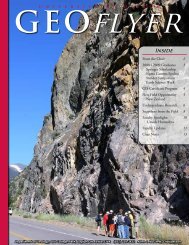Stander Symposium abstract book - University of Dayton
Stander Symposium abstract book - University of Dayton
Stander Symposium abstract book - University of Dayton
You also want an ePaper? Increase the reach of your titles
YUMPU automatically turns print PDFs into web optimized ePapers that Google loves.
9:00 AM to 5:00 PM<br />
Forensically Important Insect and Metabolic Community Differentials via Vertebrate<br />
Scavenging<br />
Presenter(s): James M Alfieri<br />
Advisor(s): Mark E Benbow<br />
Biology<br />
3:20 PM-3:40 PM<br />
Independent Research Kennedy Union - 211<br />
Blow fly (Calliphoridae) species identification is crucial to estimating a post-mortem interval (PMI) and is important for understanding the ecology<br />
<strong>of</strong> carrion decomposition. However, persisting low temperatures will greatly reduce blow fly activity, and thus affect PMI estimates during colder<br />
seasons. This leaves the process <strong>of</strong> decomposition to microorganisms that can survive low temperatures, and vertebrate scavengers. The effect <strong>of</strong><br />
these vertebrate scavengers on blow fly colonization and succession has not been thoroughly described or quantified. In this winter field experiment,<br />
six Sus scr<strong>of</strong>a carcasses were randomly placed along a field edge in Farmersville, Ohio. Three <strong>of</strong> the carcasses were placed in exclusion cages<br />
to prevent vertebrate scavenging and thus acted as a control. The remaining three were left accessible to scavengers. Stealth game cameras were<br />
set to record any motion around the carcasses, and thus any scavenging events. Initial and periodic microbial swabs were taken when scavenging<br />
occurred on a carcass to provide a metabolic pr<strong>of</strong>ile <strong>of</strong> the microbial communities <strong>of</strong> the carcass. Data suggest that there is a linear relationship<br />
between scavenging incidents and temperature. Also, carcasses that were scavenged have decomposed at an exponentially higher rate than those<br />
not scavenged. There was also a difference in microbial community metabolic pr<strong>of</strong>iles among the scavenged carcasses compared to the control<br />
carcasses.<br />
Beta diversity dynamics across topographic gradients in the herbaceous layer <strong>of</strong> an<br />
old-growth deciduous forest<br />
Presenter(s): Julia I Chapman<br />
Advisor(s): Ryan W McEwan<br />
Biology<br />
3:40 PM-4:00 PM<br />
Graduate Research Kennedy Union - 211<br />
Herbaceous species composition and productivity are known to vary with topography (i.e. slope, aspect, elevation), but how this spatial variation<br />
is linked to temporal dynamics is not well studied. We investigated the influence <strong>of</strong> topography on seasonal species turnover (beta diversity<br />
between time points) and vegetative cover over a growing season. We hypothesized that (H1) the magnitude <strong>of</strong> herbaceous layer species turnover<br />
would vary with aspect, elevation, and slope (in order <strong>of</strong> decreasing importance), (H2) herbaceous cover would vary significantly with topography,<br />
and (H3) the strength <strong>of</strong> these relationships between species turnover/cover and topography would change through the growing season. The herbaceous<br />
layer was sampled in April, June, and August <strong>of</strong> 2011 within 320 1m2 plots stratified throughout an old-growth central Appalachian forest.<br />
Percent cover was estimated for each species, and species turnover was calculated as Bray-Curtis dissimilarity.Mean seasonal species turnover<br />
was significantly greater (P < 0.001) between April and June (0.56 ± 0.02 SE) than between June and August (0.27 ± 0.02). Seasonal species<br />
turnover was generally not statistically related to topography; however, a weak linear relationship was found between aspect and turnover across<br />
the entire growing season (April to August; r2 = 0.05, P < 0.05), suggesting greater species turnover occurred on north-facing slopes. Herbaceous<br />
cover varied with elevation, and this significant quadratic relationship (P < 0.01) was consistent over time. The linear relationship between cover<br />
and aspect was stronger in April (r2 = 0.08, P = 0.01) than June (r2 = 0.05, P = 0.05), but did not exist in August. Slope was not a significant<br />
predictor <strong>of</strong> cover. Overall, local topographic variation related more strongly to herbaceous cover than species turnover, but these relationships<br />
were weak. Further work is needed to understand drivers <strong>of</strong> herbaceous layer dynamics and their interactions in eastern deciduous forests.<br />
108

















